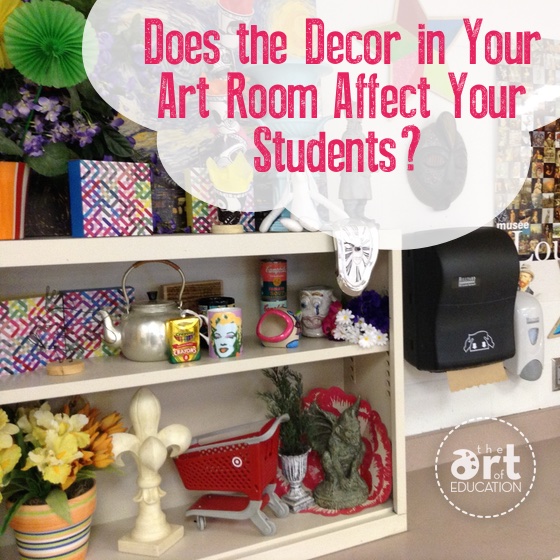Is your art room drenched from top to bottom with a wide array of decor? Rainbow tissue paper spheres hanging from the ceiling, art prints taped on every flat surface, or maybe dozens of manikins posed in every possible way hanging out on top of a bookshelf? Don’t even mention the collection of donated items and impulse garage sale purchases that fill every nook and cranny. Who knows when you are going to need that 1970s typewriter…but it does make for a great still life addition!
Or maybe you prefer a minimalist style. Clean and bare white walls, all unused supplies put away, even the surface of your own desk can be easily seen. In fact, you only keep one pencil out at a time on your desk so it doesn’t feel cluttered…

I would bet most of us fall somewhere in between the two scenarios. Either way, the decor, random objects and plain ol’ stuff in our rooms plays a significant part in our students’ learning environment. Not only can our room decor impact our students’ ability to focus and concentrate, but on an opposite note (and as an added benefit), it can unconventionally connect teachers to their students.
I have never found this to be more true than last month when I started the second semester and introduced 125 new 7th graders to the art room. In every single class when I asked if anyone had any questions, I noticed a pattern. Everyone wanted to know where I got the plastic mini Target cart that is in one of my bookcases. The story behind it is intriguing – one of my students gave it to me at the end of her 8th grade year. Her mom was a corporate Target employee and the cart is a plastic prototype made by a 3D printer about a decade ago. Supposedly, the new cart went on to win a design award. Along with the story behind my bone-dry cow skull, the super-realistic Starry Night replica and my enormous box of strawberry Jell-O, students are curious, and in fact, obsessed with the stuff in my room. All this junk has led to some serious conversations about product design and marketing, appraisal of artwork and more importantly, meaningful connections with students. So when does all of this stuff just become too much?

Last year, a study from Carnegie Mellon University suggested that highly-decorated classrooms are more of a distraction for students than sparse classrooms tend to be. I feel most of us would agree with the study’s findings that too much decor is usually a bad thing, but what about the art room? Do the rules still apply? Should a visual discipline compete with a highly-stimulating environment? Or, is simplicity and starkness in the classroom the way to go?
I try to keep my art room environment open and clean but still spark the curiosity of my students. I have no plans on packing up my Target cart, cow skull or giant Jell-O box anytime soon. I’ll substitute a few minutes of distracted students for increased student connections and conversations anytime.
What about you? What is your art room decor style? Hoarder, minimalist or in-between?
Do you have any objects in your classroom that students are drawn to?
Magazine articles and podcasts are opinions of professional education contributors and do not necessarily represent the position of the Art of Education University (AOEU) or its academic offerings. Contributors use terms in the way they are most often talked about in the scope of their educational experiences.




